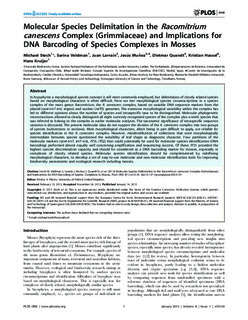| dc.contributor.author | Stech, M | |
| dc.contributor.author | Veldman, S | |
| dc.contributor.author | Larrain, J | |
| dc.contributor.author | Muñoz, Jesus | |
| dc.contributor.author | Quandt, D | |
| dc.contributor.author | Hassel, Kristian | |
| dc.contributor.author | Kruijer, H | |
| dc.date.accessioned | 2015-11-16T14:02:34Z | |
| dc.date.accessioned | 2015-11-17T09:44:20Z | |
| dc.date.available | 2015-11-16T14:02:34Z | |
| dc.date.available | 2015-11-17T09:44:20Z | |
| dc.date.issued | 2013 | |
| dc.identifier.citation | PLoS ONE 2013, 8(1) | nb_NO |
| dc.identifier.issn | 1932-6203 | |
| dc.identifier.uri | http://hdl.handle.net/11250/2360511 | |
| dc.description.abstract | In bryophytes a morphological species concept is still most commonly employed, but delimitation of closely related species based on morphological characters is often difficult. Here we test morphological species circumscriptions in a species complex of the moss genus Racomitrium, the R. canescens complex, based on variable DNA sequence markers from the plastid (rps4-trnT-trnL region) and nuclear (nrITS) genomes. The extensive morphological variability within the complex has led to different opinions about the number of species and intraspecific taxa to be distinguished. Molecular phylogenetic reconstructions allowed to clearly distinguish all eight currently recognised species of the complex plus a ninth species that was inferred to belong to the complex in earlier molecular analyses. The taxonomic significance of intraspecific sequence variation is discussed. The present molecular data do not support the division of the R. canescens complex into two groups of species (subsections or sections). Most morphological characters, albeit being in part difficult to apply, are reliable for species identification in the R. canescens complex. However, misidentification of collections that were morphologically intermediate between species questioned the suitability of leaf shape as diagnostic character. Four partitions of the molecular markers (rps4-trnT, trnT-trnL, ITS1, ITS2) that could potentially be used for molecular species identification (DNA barcoding) performed almost equally well concerning amplification and sequencing success. Of these, ITS1 provided the highest species discrimination capacity and should be considered as a DNA barcoding marker for mosses, especially in complexes of closely related species. Molecular species identification should be complemented by redefining morphological characters, to develop a set of easy-to-use molecular and non-molecular identification tools for improving biodiversity assessments and ecological research including mosses. | nb_NO |
| dc.language.iso | eng | nb_NO |
| dc.publisher | Public Library of Science | nb_NO |
| dc.title | Molecular Species Delimitation in the Racomitrium canescens Complex (Grimmiaceae) and Implications for DNA Barcoding of Species Complexes in Mosses | nb_NO |
| dc.type | Journal article | nb_NO |
| dc.type | Peer reviewed | en_GB |
| dc.date.updated | 2015-11-16T14:02:34Z | |
| dc.source.volume | 8 | nb_NO |
| dc.source.journal | PLoS ONE | nb_NO |
| dc.source.issue | 1 | nb_NO |
| dc.identifier.doi | 10.1371/journal.pone.0053134 | |
| dc.identifier.cristin | 1027591 | |
| dc.description.localcode | © 2013 Stech et al. This is an open-access article distributed under the terms of the Creative Commons Attribution License, which permits unrestricted use, distribution, and reproduction in any medium, provided the original author and source are credited. | nb_NO |
